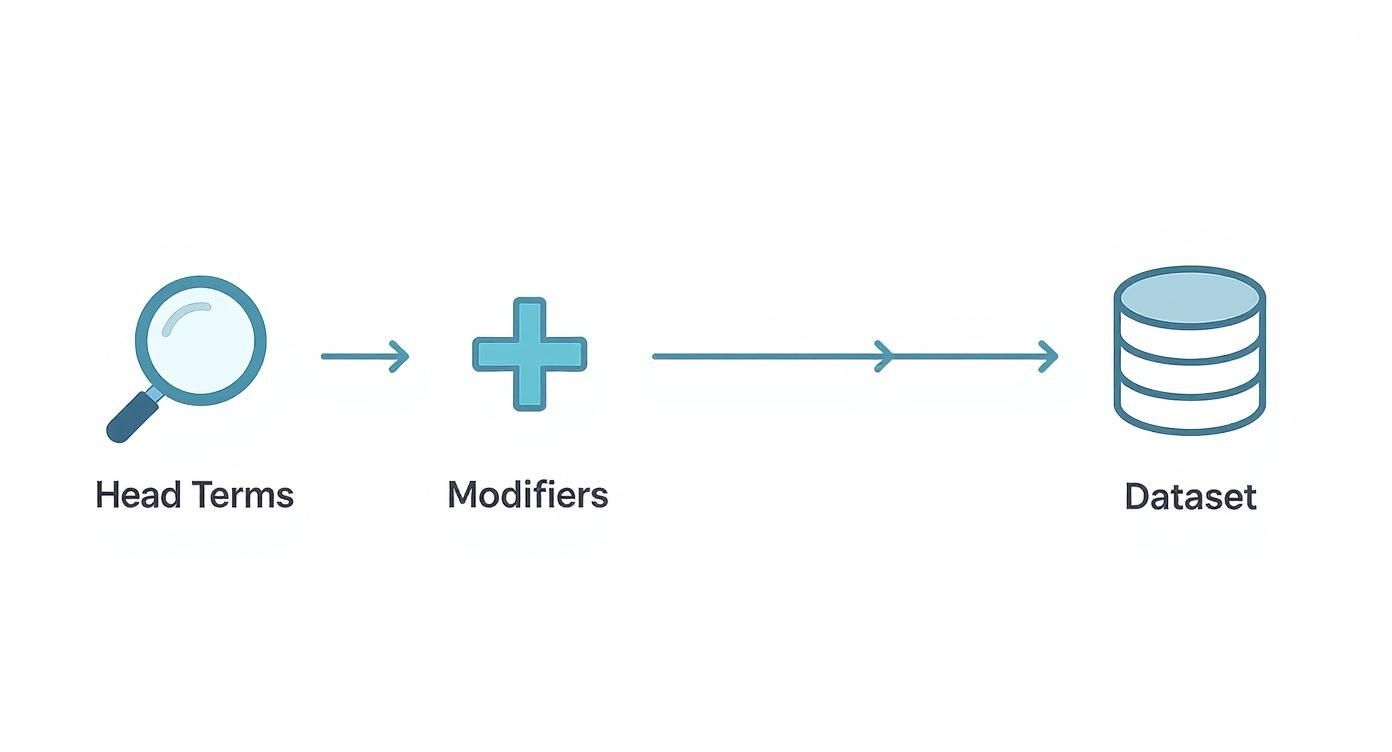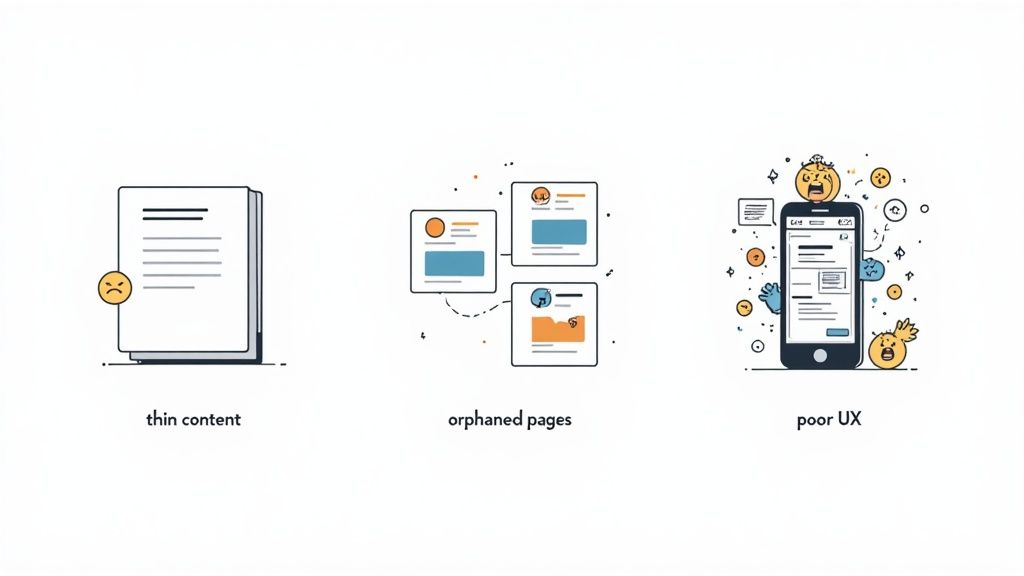What Is Programmatic SEO and How Does It Work?

Programmatic SEO is a way to create hundreds, sometimes even thousands, of unique, laser-focused web pages using a single template and a solid set of data. The whole point is to capture a massive amount of long-tail search traffic by answering super-specific questions at a scale that would be completely impossible to do by hand.
Unlocking Search Traffic At Scale
Think of it like this: you have a master recipe for a cookie. By just swapping out a few key ingredients—say, chocolate chips for oatmeal raisin or adding macadamia nuts—you can instantly whip up thousands of different cookie variations. That’s the core idea behind programmatic SEO. It’s a smart system for delivering huge value to users who are digging for very specific information.
This method is a major departure from traditional content creation, where every single page is a one-off, handcrafted project. Instead, it runs on a simple but incredibly powerful formula combining three key parts.
The Core Components of Programmatic SEO
To really get what programmatic SEO is, you need to understand its three pillars. These elements work together to turn raw data into a resource that people actually want to use.
- A Structured Dataset (The 'Ingredients'): This is your unique collection of information. It could be anything from a list of cities with their cost-of-living data, a database of software alternatives, or local business contact details. This data is the substance that makes every page valuable and different.
- A Page Template (The 'Recipe'): This is the master blueprint that dictates the structure and design for every single page you generate. It has placeholders where your unique data points get plugged in, which keeps the user experience consistent and high-quality across the entire site.
- Automation (The 'System'): This is the engine that puts it all together. It systematically pulls information from your dataset, slots it into the template, and publishes thousands of unique pages to your website, often through a CMS like Webflow.
Wikipedia is probably the most famous example of this in action. They use a consistent template for literally millions of topics, from historical figures to scientific concepts.

This strategy isn’t about pumping out low-quality, spammy pages. When you do it right, it transforms your website into an authoritative hub that answers an enormous range of specific user questions. While it shares the same end goal as manual SEO—ranking higher in search—its whole approach is fundamentally different.
If you're just starting out, it helps to understand the basics first. Our guide on how to do search engine optimization yourself covers the foundational principles that apply to any SEO effort.
The key distinction is scale. Programmatic SEO lets you target thousands of hyper-specific, long-tail keywords that would be a logistical nightmare to tackle with a traditional, one-by-one content strategy.
To put the difference in perspective, let's compare the two approaches directly.
Programmatic SEO vs Traditional SEO At A Glance
This table breaks down the fundamental differences in how each strategy operates, from the scope of content to the resources required.
| Aspect | Traditional SEO | Programmatic SEO |
|---|---|---|
| Scale | 50-500 pages, created manually | 5,000 to 5,000,000+ pages, generated automatically |
| Focus | High-volume, broad keywords | Hyper-specific, long-tail keywords |
| Content Creation | Manual, article-by-article process | Automated, template-driven generation |
| Initial Effort | Lower technical setup, high ongoing writing effort | High technical setup, low ongoing content effort |
| Speed to Publish | Slow (hours/days per article) | Fast (minutes to publish thousands of pages) |
| Maintenance | Update individual pages one by one | Update the template or dataset to change all pages |
The scale is just staggering. While conventional SEO might get you to a respectable 500 pages, a programmatic system can easily generate anywhere from 5,000 to 5,000,000 pages. You can find more insights on this scaled approach over at getpassionfruit.com.
This massive expansion allows you to capture all sorts of niche search traffic that your competitors are completely ignoring, quickly establishing your site as the go-to authority for detailed information.
The Building Blocks of a Programmatic SEO Engine
Every programmatic SEO project, no matter how big, boils down to three core pieces that fit together like a simple formula. Once you get how these pillars work, you'll start seeing opportunities everywhere, turning raw data into an asset that pulls in traffic on autopilot.
Think of it like building a machine. Each part has a job, but they only really do anything when you connect them the right way.
At its heart, this is a shift in thinking. Instead of grinding out one page at a time, you're creating a system. Each page shares the same DNA—the same template and core design—but keywords and data points change across thousands of variations. Giants like Zillow and TripAdvisor pioneered this, creating millions of unique pages for properties and destinations. It's a proven model for scaling content, and you can see a great deep-dive on it at Backlinko.
Identifying Your Head Terms
First up is the head term. This is your anchor, the foundational keyword phrase that defines why a user is searching. It’s the constant in your formula—the part that stays the same on every single page you generate.
Head terms usually signal a user's intent to find specific info, compare options, or use a tool. Get this right, and everything else falls into place.
Common head term patterns look like this:
- "cost of living in" (Informational intent)
- "best alternative to" (Commercial investigation)
- "how to connect [X] to [Y]" (Instructional intent)
- "[service] near me" (Local intent)
Picking the right head term is absolutely critical. You need to know how your audience talks and what they're looking for. Our guide on keyword research for small business is a great place to start digging for those user-intent patterns.
Finding Your Modifiers
Got your head term? Great. Now you need modifiers. These are the variables in your formula. They’re the dynamic bits that you pair with your head term to create thousands of unique, long-tail keyword phrases. Modifiers are how you get to massive scale.
A modifier can be almost any data point that creates a unique permutation of your core user query. The key is that you need a list of them to programmatically insert into your template.
Think of modifiers as the extra details a user types in to get a super-specific answer. They can be cities, brand names, job titles, product features—pretty much anything. The combination of "head term + modifier" is what generates a unique page title, URL, and H1 tag for every page.
For example, with the head term "best alternative to," your modifiers could be a list of competitor software:
- best alternative to Mailchimp
- best alternative to Slack
- best alternative to HubSpot
Just like that, one idea explodes into hundreds of hyper-targeted page opportunities.
Sourcing Your Structured Dataset
The final, and most important, pillar is your structured dataset. This is the good stuff—the unique information you deliver for each head term and modifier combo. Without a valuable dataset, you just have a bunch of empty, thin pages that won't rank and will only annoy users.
This is where you make good on the promise of your long-tail keyword. If your page title is "Freelance Rate Calculator for Graphic Designers in Canada," your dataset better have the actual numbers to make that calculator work.
Your data can come from a few places:
- First-party data: Stuff you already own, like product inventory or customer reviews.
- Third-party APIs: Pulling data from external services, like live weather or stock prices.
- Public sources: Government stats, census data, or other info that’s free to use.
- Scraped data: Information gathered from other websites (just be sure you’re doing it ethically and legally).
This unique data is what turns a generic template into a resource people actually want to use. It’s the real engine behind any programmatic SEO project that succeeds.
How to Launch Your First Programmatic SEO Project
Jumping into programmatic SEO feels like a massive technical undertaking, right? Like you need a whole team of developers just to get started. The good news is, you don't.
If you break the process down into five clear, manageable stages, you can launch a seriously powerful project, even as a one-person show. This isn't about theory; it's a lean, repeatable roadmap for getting things done.
The whole game boils down to a few core building blocks: head terms, modifiers, and a solid dataset. When you put them together, they form the foundation of your entire project.

As you can see, it all starts with combining a consistent user query (the head term) with a list of variables (the modifiers). This is how you build the structured dataset that powers everything else.
1. Discover a Scalable Keyword Pattern
First thing's first—and this is the most critical step—you have to find a repeatable search pattern. You're not just looking for a single keyword. You're looking for a formula, a "head term + modifier" combo that people are searching for over and over again. This pattern is the blueprint for the thousands of pages you're about to create.
Think about the common ways people search in your niche. Is it "best [software] alternatives"? Or maybe "[service] in [city]"? Or "how to integrate [app A] with [app B]"?
Fire up Google Search Console and Ahrefs to spot these recurring themes in what users are actually typing. Your mission is to find a formula with hundreds, if not thousands, of potential variations.
The secret is finding a query where the need is consistent, but the variables change. That consistency lets you build one amazing page template that can serve countless specific searches.
2. Source and Structure Your Dataset
Once you’ve nailed your keyword pattern, you need the data to make each page unique and valuable. This dataset is the value you're providing.
If your project is "[service] in [city]," your data will be business names, addresses, and reviews for each location. If it's "best [software] alternatives," you'll need competitor names, features, and pricing.
So, where do you get this data?
- First-Party Data: Stuff you already own, like product specs or user-generated reviews.
- Public APIs: Tapping into live data from other platforms for things like weather or stock info.
- Web Scraping: Ethically gathering public information from other websites. You could use a tool like PhantomBuster to enrich your dataset with social media profiles or other public details.
Whatever you gather, organize it meticulously in a structured database. Tools like Airtable or Notion are perfect for this. They let you create clean databases where each row becomes a future page and each column holds a specific piece of data (name, price, feature, etc.).
3. Design a High-Value Page Template
Your page template is the master recipe for every single page you generate. Don't think of it as just a container for data. It needs to be designed to deliver an incredible user experience that perfectly matches the search intent you found back in step one.
A lazy template, even with great data, will just spit out thousands of low-quality pages. No one wants that.
Focus on a clean, logical structure. You'll use your data to dynamically populate the most important on-page elements:
- Page Title:
[Modifier] - [Head Term](e.g., "Best Restaurants in Brooklyn") - URL Slug:
/best-restaurants-brooklyn - H1 Heading: "The 10 Best Restaurants in Brooklyn for 2025"
I highly recommend building your template in a powerful CMS. A tool like Webflow is ideal because its CMS Collections are literally built for this kind of work. It makes it dead simple to design a visual template and connect it to your database fields, all without writing code.
Creating a solid template is a lot like outlining a normal blog post. You can see how we structure our content by checking out our guide on the SEO content brief workflow for 2025.
4. Automate the Publishing Process
Alright, you've got your structured data and your killer template. Now it's time to connect the two and automate the whole publishing workflow. This is where the "programmatic" magic really kicks in.
You need a system that takes each row from your database (like in Notion) and automatically creates a new page in your CMS (like in Webflow) using your template.
Automation platforms like Zapier or Make.com are the glue here. You can set up a "Zap" or "Scenario" that watches for new rows in your database. When a new row appears, the automation tool instantly creates a new CMS item in Webflow, mapping each data field to the correct placeholder in your template.
This setup lets you publish hundreds or even thousands of pages without lifting a finger.
5. Monitor Performance and Iterate
Launching your pages is just the beginning. The final stage—and it never really ends—is to monitor performance and make data-driven improvements. Programmatic SEO is not a "set it and forget it" game. You have to keep a close eye on your metrics to see what's working and what's a dud.
Start with Google Search Console to track your indexation rate. Are your new pages actually getting crawled and showing up in search? If not, you might have a problem with your sitemap or internal linking.
Then, track organic traffic and keyword rankings for your pages. If you notice a certain group of pages is crushing it, dig in and figure out why. Maybe you'll find a new data point you can add or a small tweak to the template that could boost performance across the board.
This continuous loop of publishing, monitoring, and iterating is what turns a good programmatic project into a great one.
Taking a Look at Programmatic SEO in the Wild
Theory is great, but to really get a feel for how powerful programmatic SEO can be, you have to see it in action. Let's move past the definitions and break down how some of the smartest companies out there have used this playbook to generate millions of pages that absolutely dominate search results.
By reverse-engineering their approach, you'll start to see the repeatable patterns behind their success. Think of these examples as a practical blueprint to help you brainstorm and validate ideas for your own projects. Each one follows the exact same logic we’ve been talking about: a head term, a modifier, and a unique dataset.
Zapier: The B2B Integration Machine
Zapier is a masterclass in programmatic SEO for a B2B audience. Their entire business is built on connecting different apps, which creates a practically endless list of combinations that people are searching for every single day.
- Head Term: "Connect" or "Integrate"
- Modifiers: A massive database of app names (think Slack, Google Sheets, Notion)
- The Formula:
Connect [App A] to [App B] - Unique Data: This is their secret sauce. For every combination, Zapier populates the page with specific triggers and actions, real user reviews, and pre-built templates they call "Zaps." It turns a simple search query into a genuinely useful, high-value page.
The result? Thousands of landing pages like "Connect Google Sheets to Slack" or "Integrate Webflow with Brevo." Every single page perfectly matches a user’s intent to solve a specific problem, capturing traffic from people who are ready to take action right now.
TripAdvisor: The Travel Content Empire
TripAdvisor is one of the classic examples of programmatic SEO, and they’ve built an absolute empire with it. They've systematically created pages for just about every city, tourist attraction, and hotel on the planet.
- Head Term: "Things to Do in" or "Best Hotels in"
- Modifiers: An exhaustive list of cities and countries.
- The Formula:
[Top 10] Things to Do in [City] - Unique Data: The real value here comes from their massive collection of user-generated content. Each page is packed with business listings, photos, ratings, and detailed reviews from actual travelers. This provides unique, community-vetted information that both users and search engines trust.
This simple formula lets TripAdvisor rank for millions of local searches, from broad queries like "Things to do in Paris" to super-specific ones like "Best family-friendly hotels near the Eiffel Tower."
The brilliance of these examples is how simple they are at their core. They found a common, repeatable user need and built a scalable system to answer it with unique data, turning their websites into go-to resources.
Wise: Dominating Financial Keywords
Wise (which you might remember as TransferWise) took the programmatic SEO model and applied it brilliantly to the world of finance. Their goal was to intercept anyone searching for information about sending money or converting currency between two countries.
- Head Term: "Send money from" or "Convert"
- Modifiers: A list of every global currency (USD, EUR, GBP, JPY, you name it).
- The Formula:
Convert [Currency A] to [Currency B] - Unique Data: Their killer feature is live exchange rate data. For every single currency pair, they show the real-time mid-market rate, compare it to what big banks charge, and display a totally transparent fee structure. This data isn't just valuable; it's constantly updated, which signals freshness to Google.
By creating a unique, data-rich page for every currency combination you can think of, Wise jumps in front of users at the exact moment they need a solution. This strategy has allowed them to consistently outrank massive, old-school financial institutions for some of the most valuable keywords in finance.
Building Your Programmatic SEO Tech Stack
You don’t need a massive enterprise budget or a full-time dev team to get a programmatic SEO project off the ground. Far from it. A lean, carefully chosen set of tools can be incredibly powerful, especially if you're a solo founder or running a small team. The trick is to pick accessible, low-code solutions that let you focus on getting things done, not on complex engineering.
The right tools make each stage of the process smoother, from grabbing your data all the way to publishing thousands of pages. This stack is designed to be both affordable and effective, helping you build a powerful programmatic engine without the crazy overhead.
Data Collection and Management
Your dataset is the heart and soul of your project, so you need a flexible, user-friendly place to keep it organized. This is where your raw info gets structured and ready for the big stage.
- Notion: Forget thinking of Notion as just a note-taking app. Its databases are practically built for programmatic SEO. You can create highly structured tables, link related data points, and manage your entire dataset in a clean, visual interface that becomes your project's single source of truth.
- Airtable: Think of Airtable as a spreadsheet that went to the gym and got smart. It blends the simplicity of a spreadsheet with the raw power of a database, making it a fantastic choice for wrangling complex datasets with all sorts of different fields and relationships.
CMS and Page Building
Your Content Management System (CMS) is where the magic happens—where your data and templates meet to become live web pages. A no-code or low-code platform is your best friend here, letting you move fast without getting stuck in the technical weeds.
The best CMS for programmatic SEO is one that is built around structured data from the ground up. This native functionality makes connecting your dataset to your page templates seamless and intuitive.
Webflow is the clear winner for most projects. Its CMS Collections are designed specifically for building websites from structured data, making it a perfect match. If you’re in e-commerce, Shopify offers a similar power, letting you generate thousands of product pages directly from your inventory data. Both give you the ability to scale without having to write a line of custom code.
Content Enhancement and Optimization
To make sure your programmatically generated pages are high-quality and don't look like carbon copies of each other, AI-powered content tools are a massive help. They assist in optimizing your content for search engines and creating unique variations from your core data.
- Frase: Use Frase to peek at what the top-ranking content is doing for your target keywords. It will help you spot important topics and terms to weave into your page template, ensuring your generated pages are comprehensive and competitive right out of the gate.
- QuillBot: This tool is brilliant for rephrasing text and creating unique variations of your descriptions. It helps you dodge duplicate content penalties when you're generating thousands of similar pages, making sure each one feels fresh.
Project Management and Coordination
Finally, even a lean project needs a bit of organization to stay on the rails. A simple, effective project management tool makes sure no steps get missed, from sourcing the data to tracking performance. A tool like Todoist is perfect for this. You can create a simple checklist for your entire programmatic workflow, set deadlines, and track your progress without getting bogged down in a heavy-duty system. It keeps you focused on shipping, not just planning.
A well-chosen tool stack is the foundation of a successful programmatic project. Here’s a quick summary of my go-to recommendations for getting started without breaking the bank.
Lean Programmatic SEO Tool Stack
| Stage | Primary Tool | Alternative/Supporting Tool |
|---|---|---|
| Data Management | Notion | Airtable |
| CMS & Publishing | Webflow | Shopify (for e-commerce) |
| Content Optimization | Frase | QuillBot |
| Project Management | Todoist | Trello |
This stack provides a powerful, low-code foundation that lets you build, launch, and scale your project efficiently. The key is that these tools work well together and don't require a deep technical background to master, letting you focus on strategy and execution.
Common Pitfalls That Can Derail Your Project
Programmatic SEO is incredibly powerful, but it’s no silver bullet. Like any strategy that gives you this much leverage, it comes with its own set of risks that can stop a project dead in its tracks or, even worse, get your site slapped with a Google penalty. Getting familiar with these common mistakes is the first step to making sure you don't repeat them.

Think of this section as your pre-flight checklist. By tackling these issues before you launch, you’re making sure your scaled content is built on solid ground. Let’s dive into the three biggest traps that catch people out.
The Thin Content Trap
The single biggest mistake you can make is firing up the machine to create thousands of pages that offer zero real value. This is what we call thin content, and it happens when you just swap out a keyword in a template without providing any unique, helpful data for each new page. These pages don't actually help a user, and they're a massive red flag for search engines.
Trust me, Google is exceptionally good at sniffing out low-effort, templated content. If your pages are all just slight variations of one another, you risk your entire project getting ignored or even de-indexed.
The whole point of programmatic SEO is to deliver unique value at scale. If your data isn't genuinely useful for each specific search, you're not providing value—you're just making noise.
To stay clear of this, you need to enrich your dataset. Give it something unique that directly answers the user's question. For a project on "Best Restaurants in [City]," don't just spit out a list of names. You need more.
- User-generated reviews and average ratings.
- Price range info.
- Specific cuisine types and must-try dishes.
- Unique photos for every single location.
This is how you turn a generic, thin page into a genuinely valuable resource that both people and search engines will actually like.
The Orphaned Pages Problem
Another classic failure is completely forgetting about your internal linking structure. It’s all too easy to get excited after generating 20,000 new pages and then just... leave them sitting there, disconnected from the rest of your site. This creates thousands of orphaned pages that search engines will struggle to find, let alone crawl and understand.
Without those internal links, search engines have no roadmap. They can’t see how your new pages relate to each other or to your site's main content. This means no link equity flows to your new pages, leaving them stranded with little to no authority.
The best fix here is a hub-and-spoke model. Create high-level category pages (your hubs) that link out to all the specific, long-tail pages (your spokes). For instance, a "Best Restaurants in California" page would be a hub, linking down to spoke pages for Los Angeles, San Francisco, and San Diego.
Ignoring the User Experience
Finally, a terrible page template can kill a project before it ever gets a chance. You could have the best data in the world, but if your pages are a cluttered mess, slow to load, or impossible to use on a phone, users will hit the back button instantly. That high bounce rate is a direct signal to Google that your pages aren't cutting it.
Your template design absolutely must be mobile-first and built to present your unique data clearly and effectively. The goal is simple: make it incredibly easy for visitors to find the exact information they came for. A sleek, fast, and intuitive user experience isn’t a nice-to-have; it's non-negotiable for programmatic SEO success.
Still Have Questions About Programmatic SEO?
Even with a clear game plan, diving into a strategy like programmatic SEO can feel like a big leap. Let's tackle some of the most common questions that pop up. My goal is to clear up any lingering doubts before you start building.
Is This Just a Fancy Way to Create Spam?
Absolutely not, as long as you do it right. The line between valuable content and spam comes down to one thing: user value.
Spammy, auto-generated junk exists purely to game the system. It offers nothing new and just clogs up search results. High-quality programmatic SEO is the polar opposite. It takes a structured set of real data and turns it into genuinely helpful answers for very specific questions.
Think of Zillow's home listings or TripAdvisor's city guides. Every one of those pages is programmatically generated, but they're filled with real, valuable data that people are actively searching for. The entire focus is on solving a user's problem, not just ranking for keywords.
What's the Real Cost to Get a Project Started?
This is a "how long is a piece of string?" question. The investment can range from a few hundred dollars a month to tens of thousands.
A solo founder can get a lean project off the ground for a surprisingly low cost. You could use a toolstack like Airtable for your database, Webflow for the website and CMS, and Zapier to connect the dots.
On the flip side, a larger company might pour thousands into custom development, massive data scraping operations, and a dedicated team to manage it all. The smartest way to start is to build a small, focused pilot project. Prove the concept works before you go all-in with a bigger budget.
Can I Pull This Off With WordPress?
Yes, you can, but be prepared for a more technical ride compared to modern no-code platforms. Getting it to work usually involves wrestling with a combination of plugins like WP All Import and Advanced Custom Fields (ACF). You'll likely need to code custom post types just to get your templates and data structured correctly.
WordPress is incredibly flexible, but that flexibility can create a lot of complexity when you're trying to manage thousands of programmatic pages. An all-in-one solution like Webflow is often a much smoother path, simply because it was built from the ground up to handle structured data in its CMS collections.





